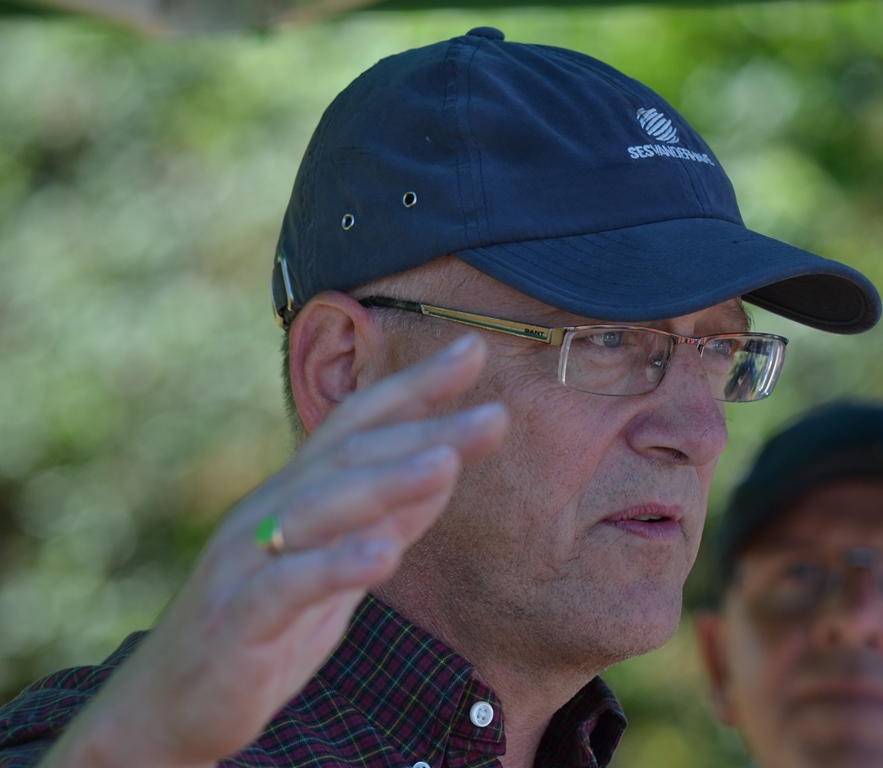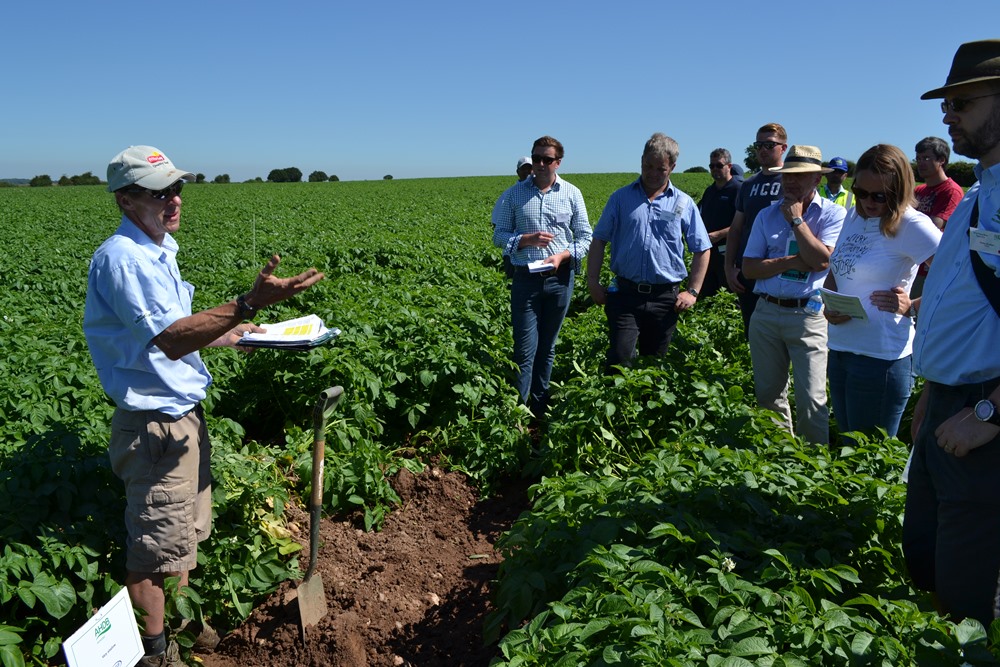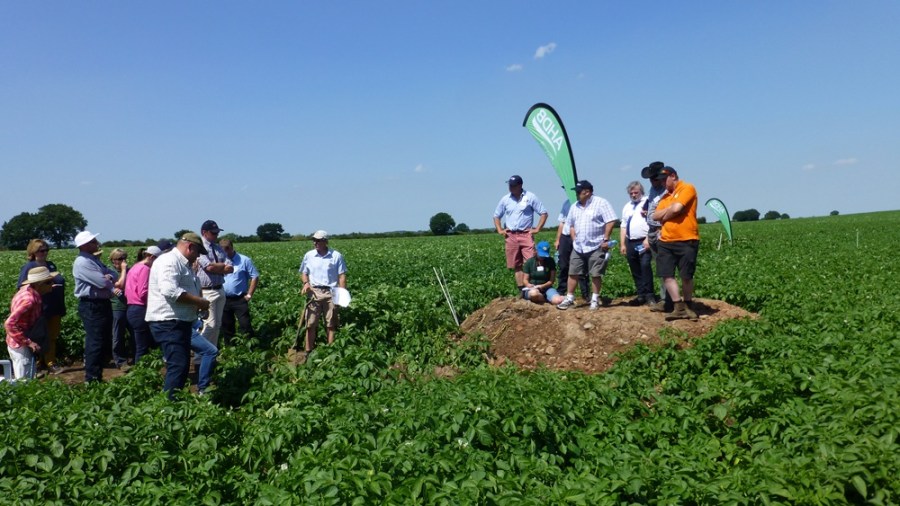A series of open days on potato farms has given growers an insight into AHDB-funded research and the latest on best practice. CPM attends one in Staffs.
This small difference in moisture content made a huge difference to the workability of the soil.
By Lucy de la Pasture
Sunscreen, baseball hats and bottles of water were all ‘must haves’ for visitors attending the AHDB’s Strategic Potato (SPot) Farm open day in Staffs on 19 July. With temperatures soaring to 33°C in the shade, the recently irrigated potato crop was faring much better than the groups looking at the demonstrations, who were definitely transpiring more rapidly…
Hosted by James Daw and his son Sam, at the Thorpe Estate near Tamworth, SPot Farm West is now in its second season. Some of the work on show is a further development from last year but there’s also new work, with cover crops and biofumigants generating particularly lively interest from growers, in spite of the heat.
Potatoes are grown one in every five years at Thorpe, with a rotation of potatoes/ winter wheat/ winter oilseed rape/ winter wheat/ winter wheat/ potatoes. The SPot programme is spread across three fields, within a commercial crop of Russett Burbank grown for processing.
The SPot fields were planted on 24 April and 5 May, with a standard cultivation regime of Simba SL, subsoiler, plough, ridger, bed-tiller, de-stoner and planter. Although at this stage in the growth of the crop all observations are purely anecdotal, there have already been some interesting issues thrown up, particularly after the late, wet spring.
One of the most eye catching was the differences in workability of the soil depending on desiccation of the cover crop, highlights Dr Marc Allison, senior researcher at NIAB CUF.

Allowing a cover crop to grow on can bring benefits of being able to travel a few days earlier, notes Marc Allison.
“We desiccated some of the cover crop of oats and vetch on 1 March but also allowed the cover crop to grow on until it was ploughed,” he explains. “After ploughing there was a visible difference in soil structure where the cover crop had been allowed to grow on and this translated into much easier secondary cultivations, with the tractor drivers reporting quicker work rates.
“The difference in soil moisture between the soil where the cover crop was desiccated and where it was allowed to keep growing was just 1%. It appears that this small difference in moisture content made a huge difference to the workability of the soil because the growing cover crop plants were pulling out water at 20-30cm depth,” comments Marc Allison.
Whether results would be the similar in a drier spring has yet to be seen, but the aim is to discover more about the effects of cover crops on soil cultivatability, he adds. In a season where planting was delayed because of wet soils, the possible benefits of being able to travel a few days earlier wasn’t lost on growers, many of whom are already growing cover crops both as greening measures and as biofumigants.
Dr Matthew Back, of Harper Adams University, talked about his experience with biofumigant crops as part of an overall control strategy for potato cyst nematode (PCN) and outlined the SPot Farm demonstration plots.
The different species that can be grown as biofumigant crops were on show: Indian Mustard (Brassica juncea), cv Caliente 199; Rocket (Eruca sativa), cv Nemat; Oilseed radish (Raphanus sativus), cv Terranova and White mustard (Sinapsis alba), cv Vitaro.

Matt Black explains the importance of matching the cover crop species you select with the function that you want it to do.
Highlighting the differences between them, Matthew Back pointed out that Indian mustard is a species that’s best suited to summer conditions as glucosinolate accumulation is dependent on higher temperatures and day length. He also noted that overwintered Indian mustard may be damaged by frosts and is likely to produce a lower biomass. All biofumigants should be chopped and incorporated at early flowering, he stressed.
Oilseed radish, on the other hand, has a larger root system and will leach (exude) glucosinolates which are then broken down by microbes in the soil to release isothiocyanates – the volatile compounds with biofumigant activity, he explained. This process is known as partial biofumigation.
“What’s important is to match the species you select with the function that you want it to do. Not all species are suitable in some rotations and can exacerbate existing problems. For example, Indian mustard and rocket cover crops are to be avoided if OSR is in the rotation and club root is a problem.”
Harper Adams PhD student, Bill Watts, explained to the group more about the biofumigant process and his work into getting the best out of chopping and incorporation techniques.
“When brassica tissue is damaged, glucosinolates and an enzyme called myrosinase are liberated from cells and interact in the presence of water. As a result of this hydrolysis, an array of volatile, biocidal compounds are released, including isothiocyanates,” he explains.
“Isothiocyanates are a similar chemical to soil sterilant, metam sodium (active ingredient is methyl isothiocynate), so once the brassica tissue is damaged, the residue needs to be quickly incorporated and the soil surface sealed to prevent the gas from escaping.”

Working soil too deeply increases fuel consumption, labour, repair and depreciation costs, says Mark Stalham.
The quality of the residue is absolutely critical for success, he reckons, with the incorporation instrument of secondary importance. “The interval between chopping and incorporation needs to be tight as possible, ideally no more than 30mins. That means a single pass operation is best,” he says, adding that at the SPot Farm, this was a front-mounted Grimme KS400 haulm topper with rear-mounted Grimme GF rotary-tiller.
“The position of the shear plate has the biggest effect on the quality of the residue, with an open shear plate giving more bruising which results in more gas being released,” comments Bill Watts. “If the crop is lush then the hydrolysis process isn’t as dependent on soil moisture, which means rainfall after incorporation isn’t essential.”
Reduced depth of cultivations
The opportunity to save costs by reduced depth of cultivations and less secondary tillage, was highlighted again this year by NIAB CUF senior researcher, Dr Mark Stalham. Work done for AHDB Project R459 (2012-2015) demonstrated that soil shouldn’t be cultivated deeper than is necessary to produce de-stoned beds of 27-28cm (clay soils 23-25cm) in depth prior to planting. Working any deeper reduced yield and increased fuel consumption, labour, repair and depreciation costs, he says.
It’s a message that’s a difficult one to convince growers, with James Daw himself cautious about going shallower than 33cm, but the SPot Farm data for 2016 again demonstrated the potential cost savings from shallower ploughing (approx. £50/ha fuel plus labour) and no bed-tilling (a further £50/ha).
“This spring where land was deep ploughed to 35cm and turned up un-weathered soil, operators reported that they had to work machines at half the speed and used more fuel than after shallower ploughing,” says Mark Stalham.
“Most clods are formed by working soil too deeply. If you cultivate at optimum moisture, then any clods are friable enough to break down with the de-stoner. If bed-forming is carried out to the correct depth, you don’t get as much clod so there’s no need to bed-till.”
Chitting trial
Another addition to the SPot programme this year is a chitting trial, demonstrated by McCain Foods’ agronomist, Matt Smallwood.
Chitting (physiological ageing) of seed has somewhat gone out of fashion with modern potato growers producing maincrop varieties, mainly because of the additional costs and labour it requires, he explains.
“The trial demonstrates the potential benefit of a conventional and large modular tray-chitting systems, designed by the Daws, in advancing canopy development, bulking and maturity on two contrasting late maturing varieties – Pentland Dell and Markies,” explains Matt Smallwood.
Seed tubers were placed in chitting trays in mid Feb, at a temperature 8-10°C under lights before a 10 day hardening-off period in natural light – a vital process when using chitted seed, he adds.
“Chitting seed gave an 8-10 day advantage in earliness of emergence and an average of 15% advantage during the canopy-expansion phase of growth. Another effect from chitted seed we’ve seen in the trial is a reduced tuber number compared with seed tubers that were unchitted and cold stored. These had a secondary initiation of tubers, resulting in 30-50% higher tuber number.
“In contrast, the chitted seed has a lower tuber number with 70-90% less tubers at <30mm, a much larger size fraction (on average >15mm in size on 13 July with a 7-8 t/ha total yield advantage), 36-43% greater than comparable cold-stored treatments,” he concludes.
The root to effective control
Matt Rodenhurst of Harper Adams University talks through the importance of applying nematicide granules into the rooting zone of potatoes. He warns that applying on a bed-tiller results in over incorporation and should be avoided.
Similarly, application on a de-stoner isn’t a reliable method either as granules are apt to stick to stones with the result that nematicide granules end up in the wheelings. Ideally nematicides should be applied as a separate operation, taking care that the speed of incorporation is greater (twice as fast) than forward movement of the tractor otherwise they’ll be folded in rather than mixed through the profile of the bed.
Age discrimination
AHDB’s Dr Phil Burgess discusses the principles determining optimum seed rates using crisping variety Taurus. He emphasises the difference chronological age, i.e. days from tuber initiation to planting, makes to the number of stems produced – older seed producing higher numbers of stems.
Acknowledging that it’s sometimes difficult to determine from suppliers, he maintains that chronological age needs to be taken into account when determining seed rates and is a useful tool that growers could exploit more to increase marketable yield.
Surviving heat stress
A soil pit dug in one of the SPot Farm demonstration fields clearly shows the depth of topsoil with roots up to 65cm deep. Dr Mark Stalham tells growers that part of the field was irrigated the day before the demo using a boom – the first time irrigation had been scheduled according to the NIAB CUF model this season.
Soils of this type – sandy loam to sandy clay loam – would have a limiting soil moisture deficit of 40mm under average evapotranspiration demand, he explains. Understanding the water demand of the crop is an important aspect of irrigation and on average the evapotranspiration rate (ET) for a crop in full canopy would be approx 3.5mm/day.
He estimates that on a day as hot as the open day, the ET was likely to be in excess of 5.5mm/day, reducing the limiting deficit for yield down to 20mm as a consequence of roots being unable to create sufficient suction in the soil to satisfy water demand.




